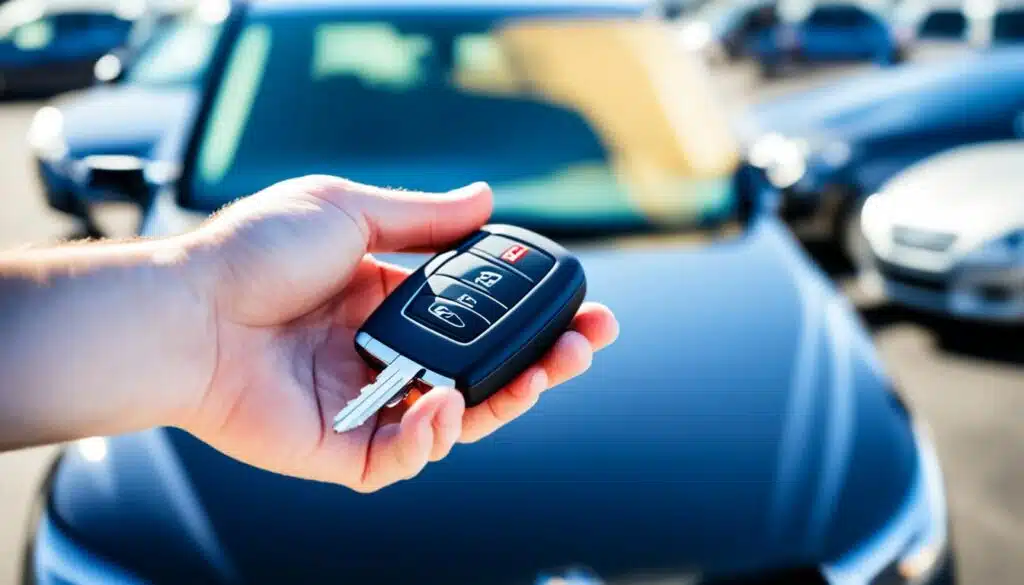Gap insurance is a type of coverage that provides financial protection for individuals who lease vehicles in the United States. It covers the difference between what you owe on a leased car and its actual cash value if the vehicle is stolen or declared a total loss. This insurance is particularly important for leased vehicles, as they tend to depreciate quickly in value. Understanding how gap insurance works can help you make an informed decision about whether to add it to your auto insurance policy.
Key Takeaways:
- Gap insurance protects individuals who lease vehicles in the United States.
- It covers the difference between what is owed on a leased car and its actual cash value.
- Leased vehicles depreciate quickly, making gap insurance crucial for financial protection.
- Understanding how gap insurance works can help make an informed decision about coverage.
Why You Need Gap Insurance for Leased Vehicles
Leasing a vehicle is a popular option for many people who want to enjoy the benefits of driving a new car without the long-term commitment of ownership. However, it’s important to understand that leasing comes with certain financial risks, especially when it comes to the value of the leased vehicle over time. This is where gap insurance comes into play.
Gap insurance is a type of coverage that provides crucial protection for individuals who lease vehicles. It covers the difference between the amount you owe on the lease and the actual cash value of the vehicle. Why is this coverage essential for leased vehicles? Let’s take a closer look.
When you lease a vehicle, you are essentially entering into a contract where you agree to make monthly payments for the duration of the lease agreement. Unlike purchasing a car, where you eventually own the vehicle after paying off a loan, leasing requires you to return the vehicle to the dealership or leasing company at the end of the lease term. This means that you do not have any equity in the vehicle.
During the lease term, the value of the leased vehicle naturally depreciates. This depreciation occurs because vehicles lose value over time due to several factors, such as wear and tear, mileage, and market conditions. As a result, the actual cash value of the leased vehicle may be significantly less than the amount you owe on the lease.
Now, imagine this scenario: Your leased vehicle is stolen or declared a total loss in an accident. Without gap insurance, you would be responsible for paying off the remaining balance of the lease, even though you no longer have the car in your possession. This could result in a significant financial burden that you may not be prepared to handle.
Gap insurance acts as a safety net in this situation. By covering the difference between the amount you owe on the lease and the actual cash value of the vehicle, it ensures that you are not left with a hefty bill if your leased car is stolen or totaled. Gap insurance offers peace of mind and protects your financial interests, giving you the confidence to drive your leased vehicle without worrying about potential financial hardships.
But how do you go about securing gap insurance for your leased vehicle? There are a couple of options available to you. You can add gap insurance to your existing auto insurance policy as an additional coverage. Many insurance companies offer this option, allowing you to conveniently bundle it with your other coverage options.
Alternatively, you can also purchase gap insurance directly from lease gap insurance companies that specialize in providing coverage for leased vehicles. These companies understand the unique needs and risks associated with leasing and can offer tailored coverage options that suit your specific situation.
Benefits of Gap Insurance for Leased Vehicles
- Financial Protection: Gap insurance protects you from the potential financial burden of paying off a leased vehicle that is no longer in your possession due to theft or total loss.
- Peace of Mind: With gap insurance, you can drive your leased vehicle with confidence, knowing that you have an extra layer of protection in case of unforeseen events.
- Save Money: In the event of a theft or total loss, gap insurance can save you from having to pay out of pocket for the remaining balance on your lease, potentially saving you thousands of dollars.
How Gap Insurance Works for Leased Vehicles
Gap insurance functions differently for leased vehicles compared to financed vehicles. With leased vehicles, the Gap Amount is determined by considering the financial obligations that would arise if the lease agreement were to be terminated prematurely. This includes any past-due amounts. The purpose of gap insurance for leased vehicles is to safeguard you against having to pay for a vehicle that you no longer possess due to the terms of a lease contract.
If gap insurance is not included or required in the lease agreement, it can be purchased separately. Many leased vehicles offer a buyout option that allows you to purchase the vehicle at the end of the lease period. However, if you decide to transition from a lease to a financing agreement, it is likely that you will need to obtain a new gap insurance policy.
| Gap Insurance for Leased Vehicles | Gap Insurance for Financed Vehicles |
|---|---|
| Calculates the Gap Amount based on the financial obligations of terminating a lease agreement. | Determines the Gap Amount by considering the outstanding loan balance on a financed vehicle. |
| Covers the difference between the lease balance and the actual cash value of the leased vehicle. | Covers the difference between the loan balance and the actual cash value of the financed vehicle. |
| Purchased separately if not included or required in the lease agreement. | Optional coverage that can be added to auto insurance policies with financing. |
| Offers protection against having to pay for a leased vehicle you no longer possess. | Provides financial security in the event of a total loss or theft. |
Source: Insure.com
What Gap Insurance Covers for Leased Vehicles
Gap insurance for leased vehicles provides coverage for the difference between the actual cash value of the car and the amount owed on the lease. This coverage is specifically designed to bridge the financial gap in the event of a total loss or theft of the leased vehicle.
When a leased vehicle is declared a total loss or stolen, the insurance company will typically pay the actual cash value of the car at the time of the incident. However, this amount may be significantly lower than the remaining lease balance. This is where gap insurance comes into play, covering the difference between the two amounts.
Note: Gap insurance coverage is only applicable if the amount owed on the lease is greater than the actual cash value of the vehicle.
It is important to note that gap insurance only covers the financial aspect of the loss. It does not provide coverage for incidentals such as lost wages, medical expenses, or repairs to the vehicle itself. Gap insurance is solely intended to protect your financial interests by ensuring you are not left with a significant debt in the event of a total loss or theft.
Although gap insurance is a valuable coverage option for leased vehicles, it should not be considered a substitute for comprehensive coverage and collision coverage. Comprehensive coverage protects against non-collision incidents such as vandalism, fire, or natural disasters. Collision coverage, on the other hand, covers damages resulting from accidents. It is important to have both comprehensive coverage and collision coverage in addition to gap insurance to ensure comprehensive protection for your leased vehicle.
The Importance of Comprehensive Coverage
Comprehensive coverage is especially important for leased vehicles as it covers a range of non-collision incidents. In the event of vandalism, fire damage, or natural disasters, comprehensive coverage ensures that you are protected financially.
The Role of Collision Coverage
Collision coverage is essential for leased vehicles as it covers damages resulting from accidents. Whether the accident is your fault or not, collision coverage will help cover the costs of repairing or replacing your leased vehicle.
The Complete Coverage Package
By combining gap insurance, comprehensive coverage, and collision coverage, you can ensure that your leased vehicle is fully protected from a financial standpoint. This comprehensive coverage package offers peace of mind and financial security in the event of a total loss, theft, or non-collision-related incidents.
When is Gap Insurance Required for Leased Vehicles
While gap insurance is not always included in lease agreements, there are instances where it may be required. It’s important to carefully review the terms of your lease to determine whether gap insurance is mandatory or optional. Some leasing companies automatically include gap insurance in the lease agreement, while others leave the decision up to the lessee.
If your lease agreement specifies that gap insurance is required, you will need to purchase it separately. This additional coverage ensures that you are financially protected in the event of theft or a total loss of the leased vehicle. Gap insurance helps bridge the gap between what you owe on the lease and the actual cash value of the vehicle, preventing you from facing a significant financial burden.
Even if gap insurance is not required in your lease agreement, it is advisable to consider purchasing it as it provides valuable financial protection. Theft or a total loss can occur unexpectedly, and having gap insurance can save you from owing a substantial amount of money on a vehicle that you no longer possess. It offers peace of mind and is a wise investment to safeguard your financial interests.
Comparison of Lease Gap Insurance Providers
| Provider | Coverage Amount | Cost | Customer Ratings |
|---|---|---|---|
| Company A | Up to $50,000 | $200 per year | 4.5/5 |
| Company B | Up to $40,000 | $150 per year | 4.2/5 |
| Company C | Up to $60,000 | $250 per year | 4.7/5 |
When considering which gap insurance provider to choose, it’s essential to compare coverage amounts, costs, and customer ratings. Company A offers coverage of up to $50,000 at an annual cost of $200, making it a popular choice among customers. Company B provides coverage of up to $40,000 at a lower cost of $150 per year, while Company C offers higher coverage of up to $60,000 for $250 annually.
It’s recommended to thoroughly research and evaluate different providers based on your specific needs before making a decision. Reading customer reviews and comparing quotes will help you select the best gap insurance coverage for your leased vehicle.
Is Gap Insurance Worth It for Leased Vehicles
Whether gap insurance is worth it for leased vehicles depends on individual circumstances. If you have a higher-risk lease, such as a longer lease term, a low down payment, or a vehicle that depreciates quickly, gap insurance can provide valuable financial protection. It can save you from having to pay out of pocket for a vehicle that is no longer in your possession.
Gap insurance offers peace of mind by bridging the gap between the amount owed on the lease and the actual cash value of the vehicle if it is stolen or declared a total loss. This coverage ensures that you are not burdened with a significant financial loss in such unfortunate situations.
Not only does gap insurance offer financial protection, but it can also save you money in the long run. Without gap coverage, you may be responsible for paying the difference between the lease amount and the actual value of the vehicle. This can result in a substantial out-of-pocket expense. Gap insurance eliminates this risk, potentially saving you from significant financial strain.
Adding gap insurance to your auto insurance policy can be a cost-effective way to ensure you have the necessary coverage in case of theft or total loss of your leased car. It provides peace of mind, knowing that you are financially protected and won’t face unexpected expenses.
Considerations for Adding Gap Insurance
Before deciding whether to add gap insurance to your auto insurance policy, it’s essential to weigh the potential cost and benefits. Consider the following:
- The depreciation rate of the leased vehicle
- The length of your lease term
- The amount of your down payment
- Your financial ability to cover any potential gap between the lease amount and the actual value of the car
Evaluating these factors will help you determine if the cost of gap insurance is worth the financial protection and peace of mind it provides.
In summary, gap insurance can be a valuable investment for leased vehicles, especially in higher-risk lease situations. It offers financial protection, saves you-money, and provides peace of mind knowing that you won’t be left with a significant financial burden if your leased car is stolen or declared a total loss.
How to Get Gap Insurance for Leased Vehicles
Getting gap insurance for a leased vehicle is a straightforward process. There are a few options available to you, depending on your preference and needs.
If you already have an auto insurance policy, you can contact your insurance provider to inquire about adding gap coverage to your existing policy. Many auto insurance companies offer gap insurance as an add-on option. This allows you to bundle the coverage with your current auto insurance policy, making it convenient and potentially cost-effective.
Another option is to purchase gap insurance directly from lease gap insurance companies. These companies specialize in providing coverage specifically tailored to leased vehicles. They have a deep understanding of the unique risks and challenges associated with leasing, and their policies are designed to address those needs. To ensure you get the best coverage at the most competitive price, it’s recommended to shop around and compare quotes from different lease gap insurance companies.
Here’s a helpful step-by-step guide on how to get gap insurance for your leased vehicle:
- Review your existing auto insurance policy to see if gap insurance is already included or available as an add-on option.
- Contact your insurance provider and inquire about adding gap coverage to your policy.
- If gap insurance is not available through your current provider or you want to explore other options, research lease gap insurance companies that specialize in coverage for leased vehicles.
- Request quotes from multiple lease gap insurance companies to compare coverage options and pricing.
- Analyze the quotes and choose the policy that best suits your needs and budget.
- Complete the application process by providing the necessary information and documentation requested by the insurance company.
- Make the necessary payment to activate the gap insurance policy for your leased vehicle.
Remember, gap insurance is an optional coverage, but it can provide valuable financial protection for your leased vehicle. Don’t hesitate to reach out to your insurance provider or lease gap insurance companies to explore your options and ensure peace of mind.
Gap Insurance vs. Other Types of Coverage for Leased Vehicles
While gap insurance provides essential coverage for leased vehicles, it is important to understand that it is not a replacement for other types of auto insurance coverage. Gap insurance functions as a supplemental coverage specifically designed to address the financial gap between the actual cash value of a leased vehicle and the amount owed on the lease.
Comprehensive coverage and collision coverage are crucial components of an auto insurance policy, as they protect your vehicle from damage or loss resulting from accidents, theft, or natural disasters. Comprehensive coverage covers non-collision incidents such as vandalism, fire, or falling objects, while collision coverage pays for repairs or replaces your vehicle if it is involved in a collision. Together, these coverages help ensure comprehensive protection for your leased vehicle.
Liability insurance is another mandatory component of auto insurance that protects you financially if you are found legally responsible for causing bodily injury or property damage to someone else. It covers medical expenses, legal fees, and property repairs or replacements for the affected parties. Liability insurance is legally required in most states, and it is essential to protect yourself from substantial financial burdens resulting from accidents.
Additionally, lease payoff coverage is a separate type of insurance that specifically covers the remaining lease payments if the leased vehicle is stolen or declared a total loss. This coverage ensures that you are not responsible for the outstanding lease balance if an unfortunate event occurs and allows you to return the vehicle without any financial obligations.
In summary, while gap insurance is important for protecting your financial interests in a leased vehicle, comprehensive coverage, collision coverage, liability insurance, and lease payoff coverage are all crucial to ensure comprehensive coverage and financial protection for your leased vehicle.
Cancelling Gap Insurance for Leased Vehicles
If you decide to terminate your lease agreement early or if you no longer require gap insurance for your leased vehicle, you may be able to cancel the coverage. The process for cancelling gap insurance varies depending on the insurance provider and the terms of the policy. It is important to contact your insurance company and notify them of your intent to cancel the coverage. They will guide you through the cancellation process and provide any necessary documentation. Keep in mind that cancelling gap insurance may result in the loss of financial protection if your leased vehicle is stolen or declared a total loss.
Example: Cancelling Gap Insurance
Here’s an example of how the cancellation process for gap insurance might work:
- Contact your insurance company by phone or email and explain that you want to cancel your gap insurance coverage for your leased vehicle.
- Provide any required information, such as your policy number, lease agreement details, and vehicle identification number (VIN).
- Ask the insurance company about their specific cancellation procedures and any documentation they may require.
- Follow the instructions provided by the insurance company to complete the cancellation process.
- Make sure to obtain confirmation of the cancellation in writing for your records.
It’s important to note that the availability and process of cancelling gap insurance may vary depending on the insurance provider and policy terms. Always reach out to your insurance company directly to ensure you have the most accurate and up-to-date information.
The Importance of Gap Insurance for Leased Vehicles
When leasing a vehicle, it is crucial to protect your financial interests. Gap insurance provides coverage that can save you from a significant financial burden if your leased vehicle is stolen or declared a total loss. This coverage is designed to protect the gap between the amount owed on the lease and the actual cash value of the vehicle.
Leased vehicle coverage is essential because leased cars tend to depreciate quickly in value. If your leased vehicle is stolen or totaled, the settlement amount from your insurance company may not be enough to fully pay off your lease. This can leave you with a substantial financial burden that you are responsible for.
Also Read:- Secure Your Future with American National Insurance
By adding gap insurance to your auto insurance policy, you can save money in the long run. In the event of theft or a total loss, your gap insurance will cover the difference between what you owe on the lease and the actual cash value of the vehicle. This can potentially save you thousands of dollars.
Having leased vehicle coverage also offers you peace of mind. You can drive with confidence knowing that even if the unexpected happens, you won’t be left with a financial burden. Gap insurance provides financial protection, allowing you to avoid the stress and worry of having to pay off a lease for a vehicle you no longer possess.
To illustrate the importance of gap insurance, consider the following scenario:
Lucy leased a car with a three-year lease term. After one year of driving, her car was stolen. Without gap insurance, Lucy would be responsible for paying off the remaining two years of her lease, despite not having her car anymore. However, since Lucy had gap insurance, her insurance company covered the difference between the amount owed on the lease and the actual cash value of the stolen vehicle. This protected Lucy’s financial interests, saving her from a substantial financial burden.
As you can see, gap insurance provides crucial financial protection for leased vehicles. It can save you money, help you avoid a significant financial burden, and provide peace of mind. When leasing a vehicle, it is essential to consider adding gap insurance to your auto insurance policy to protect yourself and your financial interests.
| Benefits of Gap Insurance for Leased Vehicles | Keywords |
|---|---|
| Financial protection | protect financial interests |
| Savings | save money |
| Avoiding financial burden | avoid financial burden |
Conclusion
Gap insurance for leased vehicles is a crucial coverage option that offers financial protection in the unfortunate event of a totaled or stolen leased car. It provides a safety net by covering the difference between the amount owed on the lease and the actual cash value of the vehicle. While it may not be mandatory in all lease agreements, adding gap insurance to your auto insurance policy can provide peace of mind and shield you from unexpected financial expenses.
Leased cars tend to depreciate quickly, making them more susceptible to a significant gap between the owed amount and the actual value of the vehicle. By opting for gap insurance, you ensure that you won’t be left with a financial burden if your leased car is declared a total loss or stolen.
To safeguard your financial interests, it is advisable to carefully evaluate your lease terms and consider the benefits of adding gap insurance to your auto insurance policy. While it may be an additional expense, the financial protection it offers far outweighs the potential cost in the long run. Don’t leave your leased car’s fate to chance; consider gap insurance as a valuable investment for your peace of mind.
FAQs
A: Gap insurance for a leased car is a type of coverage that helps cover the difference between the current market value of your leased vehicle and the amount you owe on the lease in case of a total loss.
Q: How does lease gap coverage work?
A: Lease gap coverage works by stepping in to pay the “gap” between what you owe on your leased vehicle and what your car insurance company would pay if the vehicle is totaled or stolen.
Q: Why should I purchase gap insurance for a leased car?
A: It is recommended to purchase gap insurance for a leased car because in the event of a total loss, your car insurance policy might not cover the full amount you owe on the lease, leaving you financially responsible for the difference.
Q: Does gap insurance cover the full value of my car?
A: No, gap insurance does not cover the full value of your car. It covers the difference between the actual cash value of your car and the amount you still owe on the lease or loan.
Q: What happens if my leased car is totaled or stolen without gap insurance?
A: Without gap insurance, you would be responsible for paying the difference between the insurance payout for the totaled or stolen car and the remaining balance on your lease or loan.
Q: Does gap insurance cover comprehensive and collision coverage?
A: Gap insurance does not cover the cost of repairs to your vehicle or liability for injuries in an accident. It only covers the financial “gap” between your car’s value and what you owe on the lease or loan.
Q: Can gap insurance help if my car is worth less than what I owe?
A: Yes, gap insurance can help in cases where your car is worth less than what you owe on the lease or loan. It can prevent you from having to pay out of pocket for the remaining balance.









